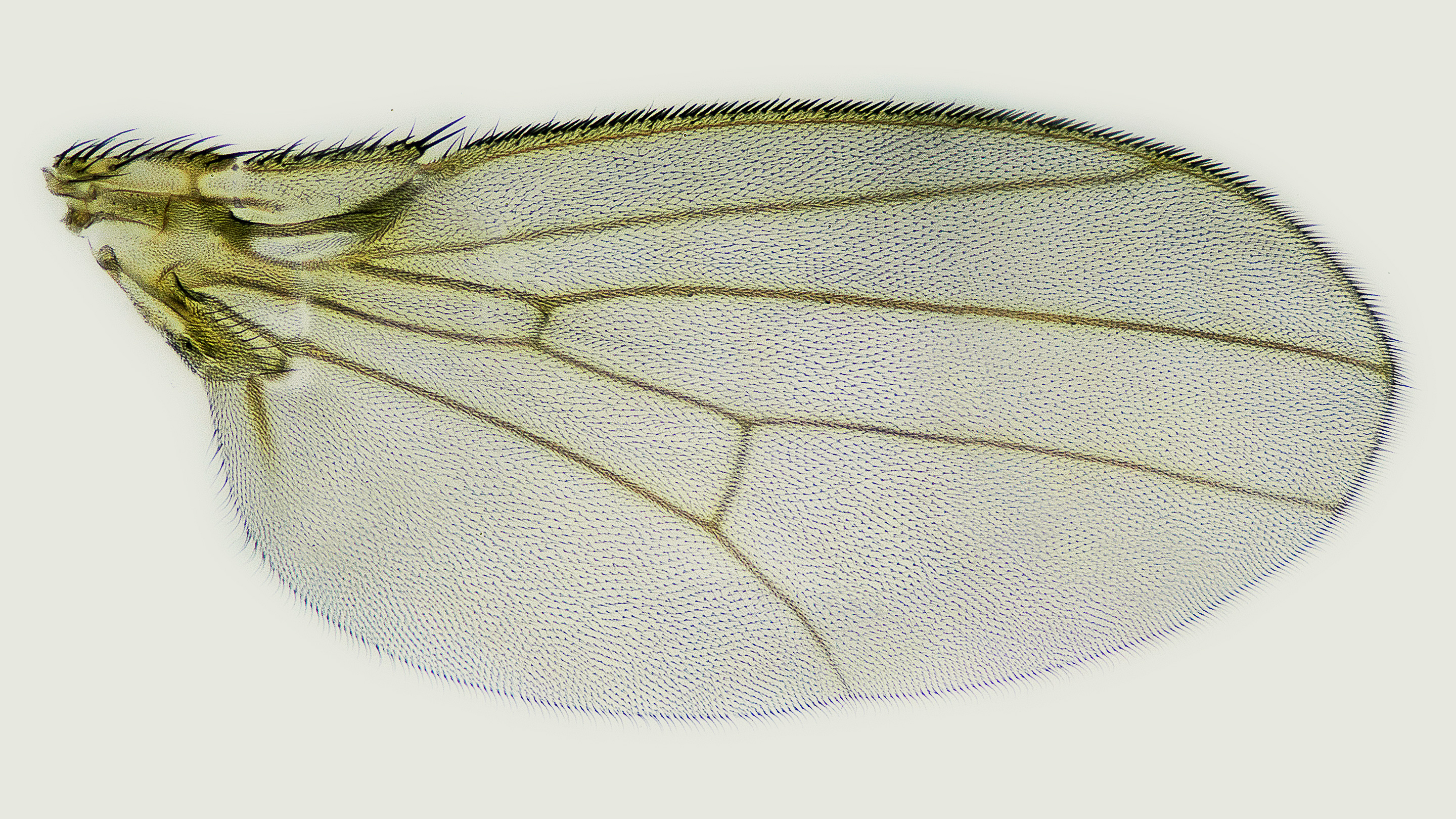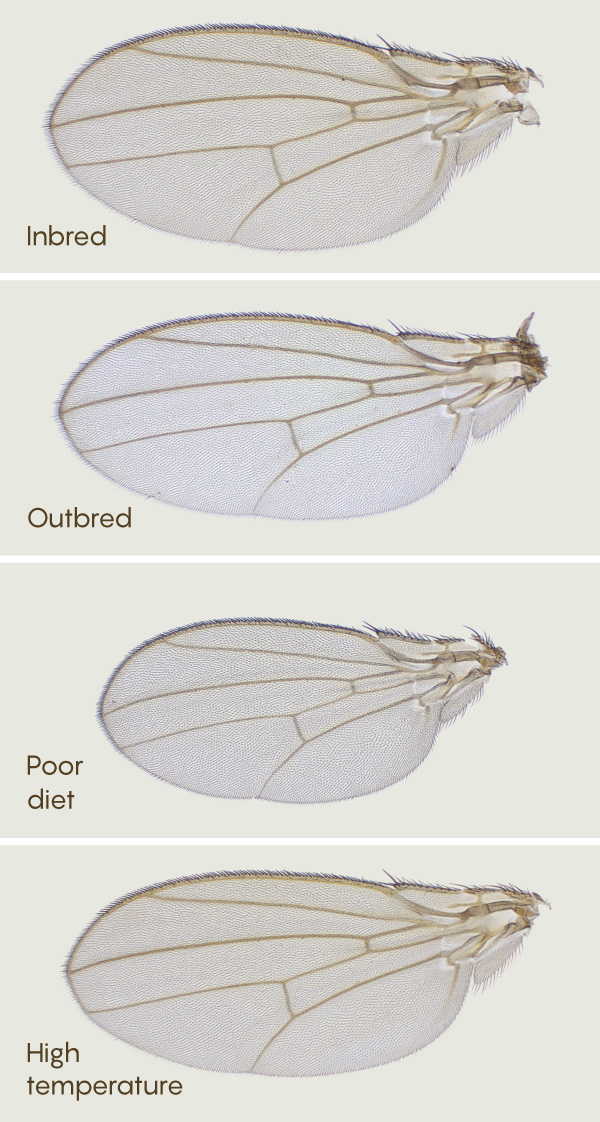Mathematical Analysis of Fruit Fly Wings Hints at Evolution’s Limits

Despite extreme differences in the genes and environments of common fruit flies, their wings are astonishingly similar, varying in a limited menu of ways.
Chris Jones
Introduction
Two years ago, to prepare for an unusual photo shoot, a team of scientists plucked the wings from thousands of fruit flies and pressed each flake of iridescent tissue between glass plates. As often as not, the wing tore or folded, or an air pocket or errant piece of dust got trapped along with it, ruining the sample. Fly wings are “not like Saran wrap,” said Madhav Mani, an applied mathematician and engineer at Northwestern University who led the project. They’re fragile, he said, “like gold leaf foil.”
Persevering until they had perfectly mounted about 2,000 pairs, the scientists then photographed the wings in high resolution and systematically compared the photos in 30,000 places.
This was no mere exercise in taxonomy. Rather, the study, which was recently published in the journal eLife, has offered an exceptionally detailed look at the variation that can exist within a species. The results begin to resolve a long-standing tension in biology.
On one hand, despite dramatic mutations in individuals’ genes and diverse environments in which they grow, members of a species develop into strikingly similar creatures. This robustness ensures that almost all individuals are functional. On the other hand, for evolution to occur, members of a species need diverse traits that natural selection can act upon. Those two forces — robustness and evolvability — tug in opposite directions. One wants less variation, and one wants more.
How is a balance struck?
Around 20 years ago, biologists expected genetics and environmental factors to produce substantial heterogeneity, giving natural selection plenty of choice, said Alex Lancaster, an evolutionary biologist at the Ronin Institute in New Jersey who wasn’t involved in the new study. But, he said, more recent observations have attested to unexpected similarity across populations.
Over dinner with co-author Richard Carthew a few years ago, Mani started thinking about pinning down exactly how much and in what ways individuals can physically vary. In other words, what options exist within the constraints of embryonic and postnatal development? For a growing organism, “What’s on the menu?” Mani wondered. “People like to say that science is some sort of method, but it started with just that childish, harebrained question.”
Prior studies relied on a few points of comparison on an organism, but Mani, Carthew and their co-authors Vasyl Alba and James Carthew (Richard Carthew’s son and a member of his lab) wanted more thorough information. They knew that, when sequencing genomes, algorithms line up sections of the genetic code for comparison. In the same way, the scientists decided to align the wings of common Drosophila melanogaster fruit flies.
Their thousands of wing photos resemble line drawings with dark veins standing out from light backgrounds. A computer program standardized these images, fitting each into a circle while preserving features such as the angles of the veins, and digitally stacked the thousands of pictures on top of one another. This gave the researchers around 30,000 points of comparison — every pixel in that stacked image — instead of a few dozen crude landmarks. “It’s more comprehensive,” said Lancaster. “It catches features that wouldn’t normally be caught.”

Drosophila melanogaster wings grown under different genetic and environmental conditions.
Samuel Velasco/Quanta Magazine; source: Vasyl Alba, Jamie Carthew and Richard Carthew
Unexpected simplicity emerged from this rich data. The scientists saw a narrow range of possible appearances for the wings, which mostly diverged in a small set of characteristics. The variation was concentrated near the hinge of the wing and showed up in a few particular spots, such as the shape of the frontmost vein. Moreover, these variable traits were linked: When one of the traits on a wing was far from the average, the other traits usually were, too. This was true no matter which genetic or environmental modifications that fly experienced, implying that these factors individually have very limited influence.
Richard Carthew had anticipated that more of the flies’ developmental complexity would be captured in their physical forms. That the variation was all funneled into a short list of menu options is “quite a marvelous thing,” he said. As flies grow into adults, they have “this magical ability to correct for differences and create a very robust final form.”
The photos of fly wings offered no clues as to the mechanisms that restrict the possible morphologies that can develop. Rather, the results substantiated the extensive power of these guardrails. Natural selection must mostly act on the significant diversity exhibited in the small number of linked, variable traits, while robustness tightly constrains the rest.
To some scientists, the simplicity isn’t surprising. Luisa Pallares, an ecologist and evolutionary biologist at Princeton University, expected restrictions on variation, based on the biological theory around robustness. That is, for members of a species to look as similar as they do, their variation must be severely restricted. But this study provides a “beautiful” quantification, she said. Now scientists can finally see the theory in action much more clearly.
Alba is a biologist at Northwestern, but he trained in physics and was drawn to the guiding principles that predict so much of the physical world. “In biology, we don’t have them,” he said. “I was always curious if it’s possible to build some set of principles for biology that will explain all or many phenomena in biology, or at least can simplify our understanding.”
To see if the restricted variation Alba and his colleagues observed holds generally across animals, more species will need to be analyzed with their quantitative approach. Carthew hopes paleontologists will try it out on fossilized teeth or bones, and Pallares is curious to see how it works on three-dimensional structures. In the future, understanding the relationship between genes and physical form could help unravel the workings of diseases, said Michalis Barkoulas of Imperial College London.
For the moment, the Northwestern team is at work on another study, which examines still more thousands of fruit fly wings. After using their quantitative approach to identify the variation in Drosophila melanogaster wing morphology, they’ve been thinking about how natural selection might have acted on their diversity of appearances to form new, closely related species. They wondered if their approach could predict the appearances of these next species to evolve from Drosophila. “Tantalizingly, it seems like we’re on the verge of saying yes,” Mani said. “We might be able to predict nearby species.”
Editor’s note: The eLife study was partially supported by a grant from the Simons Foundation, which also funds this editorially independent magazine. Simons Foundation funding decisions have no influence on our coverage.



